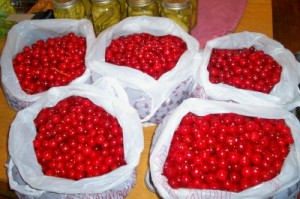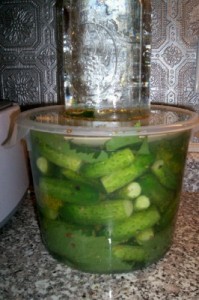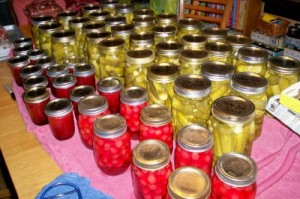It was not that long ago that I wondered if harvest season was going to pass me by this year. In the midst of our late-spring madness, in the midst of moving, I clearly recall that feeling of despair- that feeling that if the strawberries ripen too early I’m going to miss them this year. That feeling that my usual summer activities of canning the harvest for winter just weren’t going to happen because we didn’t have a place to live. Those feelings of fear were very real, but thankfully, were for naught.
Because the strawberries ripened after we’d been in our home for a whole week! I felt like we could take a day and pick berries, and then turn them into jam and freeze some for pancakes and waffles. We even went picking twice! Then the surprise of raspberries happened. I still smile when I think of that picking trip, though I’m looking at the seven jars of raspberry jam knowing full well that there is not enough raspberry jam. The blueberries were ready next, just before we headed out the door for our annual camping trip. Most of those went into the freezer, but we sure ate a lot out of hand as well! I almost made a batch of blueberry jam, but I still have quite a bit from last year, and blueberry jam is just as delicious when made from the frozen berries.
Last Friday the kids and I decided to go visit one of our favorite local farmstands and discovered they had pickling cucumbers. I bought a whole bushel before I’d really thought it through. I had a busy weekend, but surely I could find time to make pickles? Never mind the fact that I had to hunt down my wide-mouth canning jars as well… But I picked up many bunches of dill as well, and over the weekend spent time assembling batches of pickles as I could. All told I canned 34 quarts of Kosher Dill pickles.
In the middle of pickle madness, we added another something new to our list. We went to Door County here in Wisconsin and picked our fill of cherries.
Specifically, Montmorency cherries, or sour pie cherries. We picked roughly 65 pounds of cherries, but upon our return home I was reminded that I still had a good deal of cucumbers to deal with- they were older and needed to be taken care of first. So I looked up a completely new-to-me method of making pickles and set to work. I’ll share this recipe at the bottom for pickles that ferment in a crock. I made half a batch, and I’m really excited to see how they turn out. If they work… well, this opens up a whole new world for me, as I’ve really been intrigued with fermenting my own vegetables.
The new-to-us cherries are a bit of a process to deal with. Blueberries you can literally pour into freezer bags and they individually freeze on their own. The raspberries I laid out on a tray and froze before putting in a freezer bag. But the cherries… every single one needs its pit removed before anything can be done with it. We bought two different pitters in anticipation of the weekend, and the one that works the best is a very simple contraption that you screw onto a mason jar. It made quick work of the cherries! I have one bag left that I am planning to use in some fresh applications, (Hello PIE) but everything else has been put up. Many quarts were frozen in the freezer for pies later in the year, and then I also made 15 jars of jam and THEN decided it would be fun to try cherries canned in syrup.
I’ve been a little busy. The most amusing part? I have no place to put these canned goods. Andy has grand plans to build a pantry for me in the basement, but the poor guy has had no time to even think about doing that. So for now, this is what my dining room table looks like. My other canned goods are stacked about in the dining room and living room.
Don’t ask me what I’m going to do when the call comes in that my two cases of peaches are ready…
Here is my crocked pickle recipe that I mentioned above. I will definitely report back the results.
Spicy Crock Pickles– makes about 10 quarts This recipe will fill a 3-gallon crock.
2 handfuls grape or sour cherry leaves
About 12 pounds 3-5-inch pickling cucumbers, blossom ends removed
2 tablespoons Mixed Pickling Spices
1 garlic head, cloves seperated and peeled
4 to 8 dill heads
6 quarts water
1 cup cider vinegar
1 1/4 cups pickling salt
Line the bottom of a 3-gallong crock with half the grape leaves. Layer the cucumbers, spices, garlic and dill heads in the crock. Combine the water and vinegar, and dissolve the salt in the liquid. Pour the brine over the cucumbers to cover them, and lay the remaining leaves on top. Keep the leaves and cucumbers submerged by weighting them with a plate topped with a clean rock or a water-filled jar, or with a large food-grade plastic bag filled with additional brine and sealed. Cover the crock with a towel and store at room temperature.
Within 3 days you should see tiny bubbles in the brine, indicating that fermentation has begun. If a white scum forms on top of the brine, skim it daily, and rinse and replace the plate and weight or the brine bag.
The pickles should be ready in 2-3 weeks, when the pickles are sour and olive-green throughout. Skim off any scum.
Pour the pickles and the brine into a colander set on top of a nonreactive pot. Discard the leaves and spices. Remove the colander from the pot and transfer the pot to the stovetop. Bring the brine to a boil, reduce heat to low, and simmer the brine for 5 minutes. Skim off the scum that forms. Rinse the pickles with cold water and drain them well.
To store the pickles in the refrigerator, let the brine cool to room temperature. Pack the pickles into 2-quart or gallon jars. If you like, add fresh garlic, dill and spices. Pour enough cooled brine over the cucumbers to cover them well. Cap the jars and store in the refrigerator for up to 6 months.
For pantry storage, pack the pickles into quart or pint mason jars. Cover the pickles with the hot brine, leaving 1/2-inch headspace. Close the jars with two-piece caps. In a boiling-water bath, process pint jars for 10 minutes, quart jars for 15 minutes. Or pasteurize the jars for 30 minutes in 180ºF to 185ºF. When the jars have cooled, store in a cool, dry, dark place.



